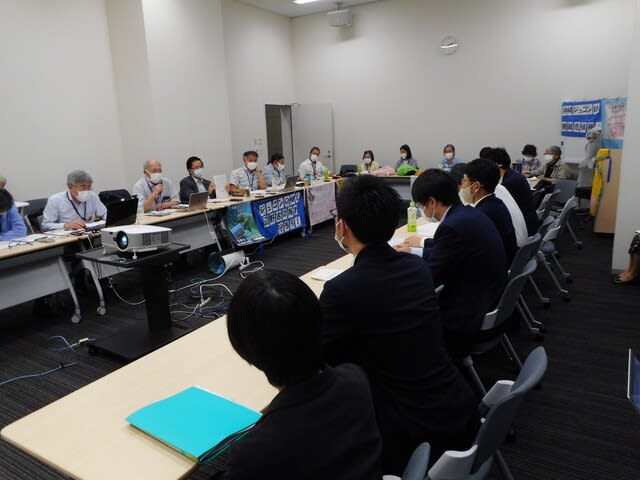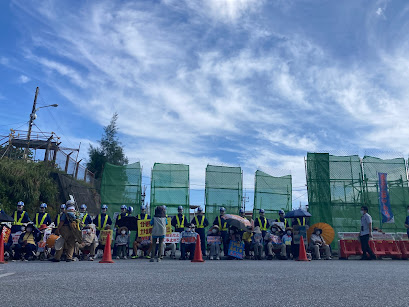Declaring Extinction of the Okinawa Dugong: A Scientific Misstep or Political Pandering?
I had just written blog articles on the Okinawa Prefectural Government's report and the Ministry of the Environment's reports that dugong feeding trails were found in several parts of the waters of Okinawa, including the waters of northern Okinawa Island, during their 2020 fiscal surveys. So, I was confused and could not understand what was happening while reading the abstract.
 |
| Image Source: Research Square |
Then, I looked at the names of the authors and realized that four of them were very familiar. Three of them are current members, and the other is a former member of the Environment Monitoring Committee set up by the Okinawa Defense Bureau. The Committee is assigned to oversee and advise regarding the impacts of the Defense Bureau's ongoing construction of a U.S. military base on the Environment in Henoko-Oura Bay.
Immediately, I began to suspect that the article should be related to the base construction project.
The Committee has never acknowledged that base construction has impacted the Okinawa dugong and the Environment of Henoko-Oura Bay. In turn, the Okinawa Defense Bureau has referred to the Committee's "no impact" evaluations to legitimize its continuation of construction work. To me, the Committee has been an enabler of the destructive base construction project.
Given the Committee and the Defense Bureau maintain that base construction has no impact on the dugong, I was worried, the declaration of extinction of the Okinawa dugong could relieve the Ministry of Defense of the responsibilities it faces. The Ministry could ignore as irrelevant these 200 "possible dugong calls" recorded near the construction site in Oura Bay in 2020. It could dismiss NGOs and international organizations' calls for protecting the Okinawa dugong. It could also disregard any dugong-related arguments by Okinawa Governor Denny Tamaki when he rejects the Okinawa Defense Bureau's application for changes in construction design and works in the coming months. I could see this potential and destructive power of the article if it was accepted as legitimate.
Still, I was not sure what I should make of the article. With these dugong feeding trails in the waters around northern Okinawa Island, the article's title seemed too absurd. I contemplated the possibility that the title might have been meant to attract more readership thought it was bad taste and inappropriate. I also thought that the title might have been a result of a bad translation. However, I concluded that a respected scientist would not submit a poorly translated article to any academic journal.
They also argued that "Long-lived animals fall below the MVP; thus, active conservation measures should have been taken much sooner than when the actual extinction happened." (p.2). This argument discredits the conservation efforts civil society, the Okinawa Prefectural Government, and the Ministry of the Environment have made for the last 20 years. The article also makes no mention of the base construction, which should be considered as the most critical factor impacting the Okinawa dugong for the last 3 years.
Let me be clear. I totally support the idea of academic freedom, and I believe that authors can write whatever they want to write as long as what they write adheres to scientific standards and integrity. I also understand how the peer review process works and that the article was just about to enter a formal reviewing process when I spotted it.
Still, the article was too much for me to take. I was especially disturbed by the authors' cherry-picking of studies, reports, and data. It was hard to believe that their omission was a careless mistake.
I thus submitted the following comments to the Research Square portal site.
The following suggestions are offered.
1) The article should benefit from incorporating and discussing the IUCN's 2019 assessment of the Nansei subpopulation dugong (Okinawa dugong) as "Critically Endangered" and the methodologies employed in declaring a species's extinction by the IUCN Red List. By way of comparison, such discussion could help delineate the strengths and limitations of PVA and MVA as tools to determine a species extinction. https://www.iucnredlist.org/species/157011948/157011982#assessment-information
2) The article should benefit from incorporating and discussing the following dugong reports by the Japanese Ministry of Defense, the Japanese Ministry of the Environment, and the Okinawa Prefectural Government.
2-2 The environment ministry's report (2021) discusses that in 2020 dugong feeding trails were found near Kouri Island off the west coast of northern Okinawa Island and in the Yaeyma and Miyako regions down south. https://www.env.go.jp/nature/kisho/r2_jyugon.pdf (in Japanese)
2-3 The prefectural government report (2021) discusses that in 2020 dugong feeding trails were found near Kouri Island and Yagaji Island off the west coast of northern Okinawa Island and near Izena Island northeast of Okinawa Island. https://www.pref.okinawa.jp/site/kankyo/shizen/documents/r3honpen.pdf (in Japanese)
While these new reports are probably unlikely to change the article's assessment of the viability of the dugong subpopulation in Okinawa, they would place its analysis and assessment in an updated context and encourage further discussion, especially on the nature of data and data collection for PVA and MVP.
3) This article would be more valuable if it could address in more detail how a small number of surviving individuals should be treated when PVA and MVP analyses indicate their population is not viable or extinct. Instead of concluding that "Long-lived animals fall below the MVP; thus, active conservation measures should have been taken much sooner than when the actual extinction happened," the article should provide more practical suggestions and discussions similar to the IUCN Sirenian Group's "A Research Plan for the Japanese Dugong Sub-Population" (2019). https://www.mmc.gov/wp-content/uploads/A-Research-Plan-for-the-Japanese-Dugong-Sub-Population-111119.pdf
 |
| Dugong feeding trails found near Kouri Island in June 2020. Image Source: Ministry of the Environment |
However, the critical question is why the authors wrote this article and submitted it to an international journal when they did, against the evidence indicating that dugongs, though in a very small number, are still surviving. Put it differently, is the article a scientific misstep or political pandering to the base construction project?
Efforts are now underway to find answers to these questions in the public field. On May 28, 2021, Kyodo News ran a piece on the article, and it found its way into many other local newspapers throughout Japan. It pointed out that the evaluation of the Okinawa dugong as extinct contradicts the Ministry of the Environment's reports and the IUCN's evaluation of the dugong in the Nansei Region. It also quoted one of the authors saying that the extinction was made based upon the data gathered from dugong sightings, and the content of the article could change according to peer reviews.
 |
| Kyodo News article in Tokyo Shimbun Image Sorce: Tokyo Web |
On the same day in Tokyo, environmental NGOs, including myself, met and ask questions about the article with officials from the Ministry of Defense and the Ministry of the Environment.
We asked them to present the ministries' assessments of the status of the Okinawa dugong in relation to the article's extinction claim. The officials from both ministries answered that the status of the Okinawa dugong is critically endangered in need of protection, not extinct.
We questioned the Defense officials whether the Ministry requested the authors to write this article. We also asked whether they thought it was appropriate for the authors on the Environmental Monitoring Committee to make such a claim when evidence suggests otherwise. The officials responded that they could not comment on the article because they considered it an academic activity of individual scientists.
We also asked the Environment Ministry officials whether they thought it was appropriate for the authors on the Environmental Monitoring Committee to make such a claim when evidence suggests otherwise. They did not know of the article until they read the Kyodo News pieces on that morning. They responded that they could not make any comments.
On June 1, Iha Yoichi, a member of the House of Councilor, took the issue onto the National Diet floor. He asked whether the Ministry of Defense requested the authors to write the article, and the Ministry answered it did not make such a request. Iha also questioned Defense Minister Kishi Nobuo how the Ministry would regard the article written by members of the Environmental Monitoring Committee. Iha then requested that the article be discussed in the Environmental Monitoring Committee. In response, Defense Minister Kishi reiterated that he could not comment on the article because he considered it an academic activity of individual scientists. Kishi also stated that any decisions over whether the article should be discussed in the Committee should be decided by the Committee itself.
 |
| NGOs and National Diet Member Iha Yoichi met with Defense Ministry Officials Image Source: SDCC |
Concluding Notes
The article is now undergoing a peer-review process at Scientific Reports, and more information could come as public comments. Such information could include suggestions for incorporating additional dugong reports from the Okinawa Prefectural Governments and the Ministry of the Environment. It could also include recommendations for making more transparent the relationship between the article and the authors. The authors declared to Scientific Reports that there were no competing interests regarding the article. The fact that the three of them currently sit on the Environment Monitoring Committee may need to be provided to the journal as information.
Meanwhile, it remains to be seen whether the Environment Monitoring Committee could examine the article in terms of its scientific values and integrity and its various implications for the committee. The Ministry of Defense could insist that the article is an academic activity of individual scientists. However, the rest of the Committee members could not and should not take the same stance. The article was written by those who sit just next to them. It is about the survival of the Okinawa dugong, a topic that the Committee has discussed for the last six years. I hope that they take issue with the article for their own sake as scientists.
The extinction article is now under intense scrutiny at both domestic and international levels for its scientific values and integrity as well as for its political implications. It is ironic that the authors writing an article claiming the Okinawa dugong extinct now have to see whether and how the very article will survive.
Hideki Yoshikawa
Okinawa Environmental Justice Project



